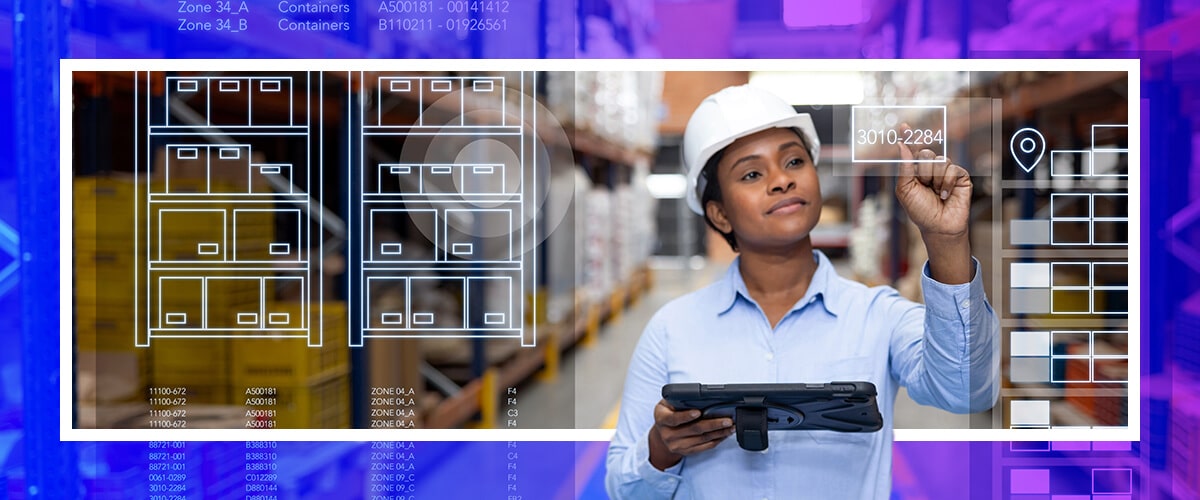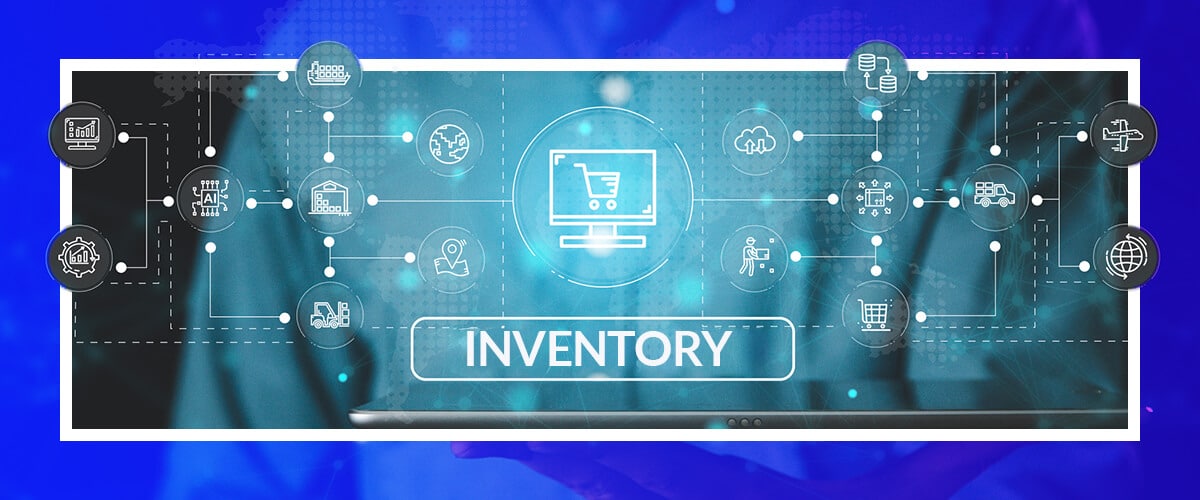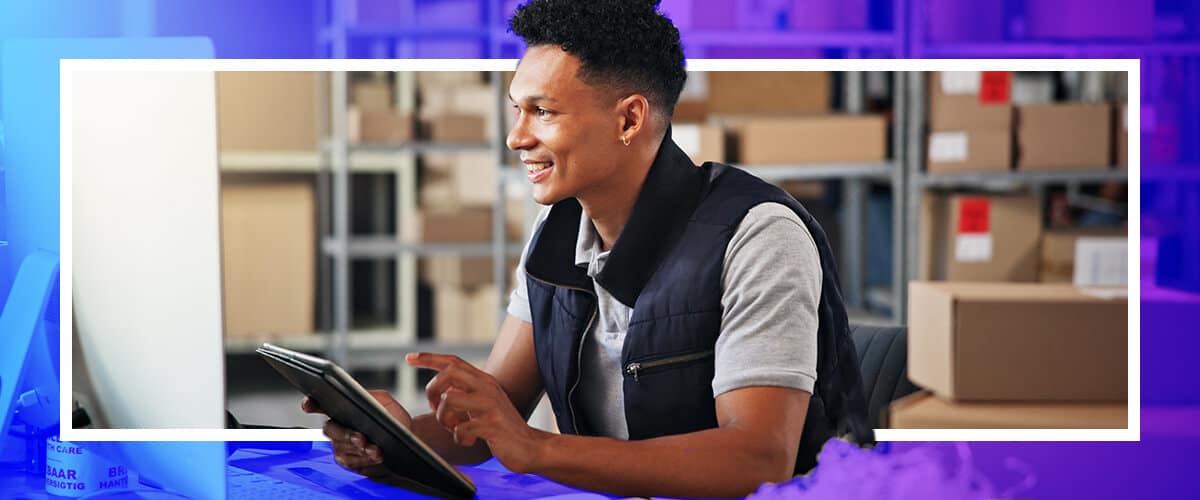Instead, there’s a need for a new generation of intelligent and connected technologies that can transform warehouse function at scale. These technologies provide real-time visibility, predictive orchestration, and so much more.
In this article, we discuss these innovations and explore how every warehouse technology can create value for businesses.
- Key takeaways on leading warehouse technologies
- Technology 1: Advanced warehouse automation and robotics
- Technology 2: AI in warehouse management
- Technology 3: Internet of Things for supply chain and warehouse operations
- Technology 4: Blockchain in warehousing
- Technology 5: Cloud-native platforms
- Is your warehouse technology ready for the future?
- FAQs about warehouse technologies in 2025
Key takeaways on leading warehouse technologies
- AI and machine learning provide predictive power for demand forecasting and advanced automation, while robotics (AMRs, AGVs, AS/RS) reduce labor dependency and increase operations speed.
- IoT technologies (RFID, sensors, wearables) deliver real-time visibility into inventory and blockchain provides end-to-end traceability and data security.
- Cloud-native platforms allow for rapid deployment, seamless integrations, and global scalability.
- Logiwa IO’s AI-driven fulfillment management system (FMS) provides powerful integrations to unify the modern warehouse enterprise tech stack. Schedule a demo to see how Logiwa turns warehouses into a true competitive advantage.
Technology 1: Advanced warehouse automation and robotics
Warehouse automation and robotics provide a level of performance and responsiveness that manual labor alone can’t match.
Automation that scales with demand
Modern fulfillment environments are turning to autonomous mobile robots (AMRs) and automated guided vehicles (AGVs) to move goods across warehouse floors without human intervention. Robotic picking systems are now integrated directly into fulfillment lines. Similarly, automated storage and retrieval systems (AS/RS) help minimize space usage while maximizing throughput in multi-level or high-density facilities.
The real advantage lies in their 24/7 operability and consistency. These automated systems also maintain optimal performance across shifts and seasons.
For warehouse managers, this translates to faster order processing and lower overhead. So, automation enhances agility and resilience to turn operational efficiency into a competitive edge.
Technology 2: AI in warehouse management
AI has been a buzz word for some time. Today we’ve moved beyond the hype and are seeing real-world productivity improvements on the warehouse floor. Beyond modern warehouse managers’ need for systems that can interpret patterns and recommend action before issues arise, automation in warehouse processes is delivering huge gains.
From reactive to predictive warehouse operations
AI and machine learning are helping warehouse operations move from reactive to predictive across multiple fronts. In demand forecasting, AI analyzes historical sales data, seasonal trends, and market signals to predict stock needs.
For inventory optimization, AI evaluates SKU velocity and warehouse zoning to recommend optimal storage locations and replenishment strategies. Predictive maintenance is another high-impact use case. Instead of waiting for equipment to fail, AI models monitor sensor data to anticipate breakdowns, which reduces costly downtime and extends asset lifespans.
In labor planning, AI helps manage and align workforce allocation with peak periods. Even internal routing is benefiting from AI-powered systems. The technology optimizes picking paths and delivery sequences, factoring in task traffic and task priority.
These capabilities facilitate smarter and faster decisions at every level, be it daily floor operations or long-term strategic planning. The result is improved resource allocation and a warehouse that runs with foresight.
Technology 3: Internet of Things for supply chain and warehouse operations
The use of IoT for supply chains is making visibility possible at scale. Enterprises are increasingly embedding sensors, RFID tags, and connected devices across their operations to create a living, breathing warehouse ecosystem.
Sensor-driven visibility for inventory, equipment, and staff
IoT devices give the warehouse a real-time pulse on everything from inventory levels to staff activity. RFID tags and smart shelves can track the exact location and movement of SKUs and reduce the risk of misplaced items.
For cold chain and high-sensitivity products, IoT sensors monitor temperature, humidity, and handling conditions. They trigger alerts if thresholds are breached so teams can intervene before there’s a product integrity compromise.
Wearables and badges are also becoming standard tools for workforce visibility and safety. They allow managers to monitor movement and make sure their teams are operating in safe zones.
On the equipment front, connected forklifts and robotics feed performance and usage data to centralized systems. They enable real-time tracking and preventive maintenance.
Together, these IoT devices help warehouse managers get unprecedented situational awareness and control for faster decisions and smarter responses across the entire operation.
Unlock a personalized tour of Logiwa IO
Technology 4: Blockchain in warehousing
Traditional databases struggle to meet the demands of data tamper-proofing and trust. Meanwhile, blockchain helps warehouse managers oversee multi-party operations with a more secure and verifiable logistics infrastructure.
Securing a new class of industrial edge devices
Blockchain allows warehouses to log and share critical data across the supply chain with a level of transparency and immutability that traditional systems can’t match. The warehouse technology creates a permanent, time-stamped audit trail. It’s particularly valuable for tracking high-value items and verifying product authenticity.
Integrated with edge devices like smart scanners, IoT sensors, and RFID readers, blockchain can validate data as it’s collected in the warehouse. Temperature logs, shipment verifications, and inventory counts are consequently trustworthy internally and across partners and regulatory bodies.
Blockchain results in better supplier collaboration, faster dispute resolution, stronger compliance with minimal manual reconciliation, counterfeit protection, and data integrity.
Technology 5: Cloud-native platforms
Legacy warehouse management systems (WMS) slow down innovation due to rigid architectures and costly on-premise upgrades. Meanwhile, cloud-native platforms facilitate quick scaling and stability.
Scalable, flexible, and faster rollouts
Cloud-native platforms are built for distributed environments. While older WMS solutions require extensive hardware, manual updates, and siloed data, cloud-native systems like Logiwa IO offer centralized control and seamless connectivity.
One of their biggest advantages lies in integrations. Cloud-native systems have open APIs that make it easy to connect with third-party tools, be it robotics or ecommerce platforms. The modularity allows enterprises to build flexible tech stacks over time.
Multi-tenant architecture also allows enterprises to manage multiple clients securely. When combined with real-time API endpoints and live data feeds, warehouse managers gain full operational visibility and control without the IT burden.
These platforms help warehouse managers move faster and integrate smarter. More importantly, they facilitate scaling without friction.
Is your warehouse technology ready for the future?
Moving forward, warehouse management will be a blend of strategy, advanced automation, robotics, AI-powered forecasting, and more.
Key questions fulfillment leaders should be asking
The following questions will help warehouse CTOs and managers analyze their practices and identify areas for improvement.
- Can your WMS platform adapt as fast as your business changes?
- Is your warehouse a cost center or a competitive advantage?
- Are your teams making decisions with real-time data or outdated dashboards?
- Do your security protocols account for physical-digital convergence?
Advanced automation and robotics, AI-powered forecasting, IoT visibility, blockchain-secured traceability, and cloud-native platforms are making modern enterprise operations faster and better. Strategic adoption of these tools is imperative to overcome labor shortages and meet the demand for faster fulfillment.
For enterprise leaders ready to make that leap, the opportunity is clear: transform the warehouse from a logistical necessity into a true engine of competitive advantage. Logiwa can help. Schedule a demo and let us show you how.





